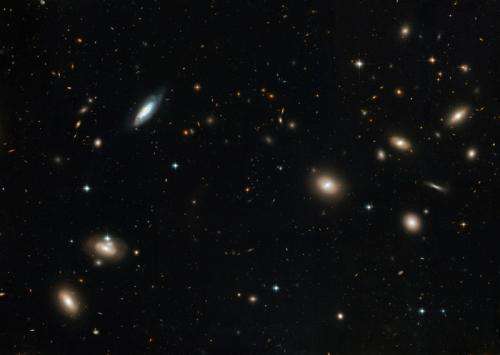Astronomers reveal a cosmic 'axis of evil'

(PhysOrg.com) -- Astronomers are puzzled by the announcement that the masses of the largest objects in the Universe appear to depend on which method is used to weigh them. The new work was presented at a specialist discussion meeting on 'Scaling Relations of Galaxy Clusters' organised by the Astrophysics Research Institute (ARI) at Liverpool John Moores University and supported by the Royal Astronomical Society.
Clusters of galaxies are the largest gravitationally bound objects in the Universe containing thousands of galaxies like the Milky Way and their weight is an important probe of their dark matter content and evolution through cosmic time. Measurements used to weigh these systems carried out in three different regions of the electromagnetic spectrum: X-ray, optical and millimetre wavelengths, give rise to significantly different results.
Eduardo Rozo, from the University of Chicago, explained that any two of the measurements can be made to fit easily enough but that always leaves the estimate using the third technique out of line. Dubbed the 'Axis of Evil', it is as if the Universe is being difficult by keeping back one or two pieces of the jigsaw and so deliberately preventing us from calibrating our weighing scales properly.
More than 40 of the leading cluster astronomers from UK, Europe and the US attended the meeting to discuss the early results from the Planck satellite, currently scanning the heavens at millimetre wavelengths, looking for the smallest signals from clusters of galaxies and the cosmic background radiation in order to understand the birth of the Universe. The Planck measurements were compared with optical images of clusters from the Sloan Digitised Sky Survey and new X-ray observations from the XMM-Newton satellite.
ARI astronomers are taking a leading role in this research through participation in the X-ray cluster work and observations of the constituent galaxies using the largest ground-based optical telescopes.
One possible resolution to the 'Axis of Evil' problem discussed at the meeting is a new population of clusters which is optically bright but also X-ray faint. Dr Jim Bartlett (Univ. Paris), who is one of the astronomers who presented the Planck results, argued that the prospect of a new cluster population which responds differently was a 'frightening prospect' because it overturns age old ideas about the gravitational physics being the same from cluster to cluster.
Chris Collins, LJMU Professor of Cosmology, who organised the meeting said: 'I saw this meeting as an opportunity to bring together experts who study clusters at only one wavelength and don't always talk to their colleagues working at other wavelengths. The results presented are unexpected and all three communities (optical, X-ray and millimetre) will need to work together in the future to figure out what is going on.'
Provided by Royal Astronomical Society



















